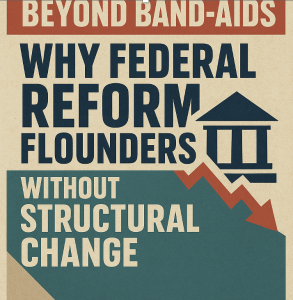Widgetized Section
Go to Admin » Appearance » Widgets » and move Gabfire Widget: Social into that MastheadOverlay zone
Beyond Band-Aids: Why Federal Government Reform Flounders Without Effective Structural Change
The views expressed are those of the author and do not necessarily reflect the views of ASPA as an organization.
By Bill Brantley
May 16, 2025

Government reform efforts in Washington often aimed to address federal inefficiencies but rarely achieved significant results. Despite various commissions and management agendas, most reforms focused on minor adjustments like budget cuts or organizational changes rather than deep structural transformations.
A Century of Cautious Reform
The Hoover Commission (1947–49), chaired by former President Herbert Hoover, was a bipartisan commission that suggested structural changes resulting in the creation of the Executive Office of the President and the consolidation of several agencies. With President Truman’s support, many recommendations were implemented. This initiative demonstrated that bipartisan collaboration could facilitate significant structural changes.
Later efforts, such as the second Hoover Commission and Reagan’s Grace Commission, had limited success. The Grace Commission proposed nearly 2,500 cost-saving recommendations, many of which were not politically feasible or were overstated. Although Reagan implemented some administrative changes, the GAO reported that the total savings were minimal. These commissions produced extensive reports but did not have a lasting impact.
Clinton’s Reinventing Government (1993–2000), led by Vice President Al Gore, focused on streamlining operations within agencies instead of structural changes. The National Performance Review achieved savings and better service delivery but these improvements weren’t sustained after Clinton’s term.
President George W. Bush’s Management Agenda (2001–2008) focused on achieving measurable improvements through the implementation of quarterly scorecards and performance-based budgeting. This initiative led to enhancements in financial and workforce management within various agencies; however, it did not address structural reform. Like previous administrations, the Bush reforms optimized existing systems rather than fundamentally redesigning them.
Obama’s Digital Initiatives (2009–2016) introduced government to the digital age. Open data, agile development and technology teams like the U.S. Digital Service worked on modernizing IT infrastructure. These initiatives improved transparency and service delivery but did not restructure agencies or remove redundant functions. They added new capabilities without changing the fundamental structure of the government.
Trump’s 2018 plan, “Delivering Government Solutions in the 21st Century,” aimed to merge the Departments of Education and Labor and privatize the Postal Service. Congress did not approve these changes. Instead, the administration focused on reducing regulations and implementing hiring freezes, leaving systemic issues unresolved.
DOGE: A Cautionary Tale in False Reform
The Department of Government Efficiency (DOGE), created in 2025 by President Trump and inspired by Elon Musk, aggressively fired staff, halted projects and closed offices without adequate planning. Musk claimed to dismantle structures “with no plan to replace them,” according to Harvard’s Linda Bilmes.
DOGE caused chaos instead of efficiency, leading to mistaken terminations and rehiring of key public health staff like flu epidemiologists. Staff morale and productivity suffered due to weekly documentation requirements. While $160 billion in savings were claimed, hidden costs of $135 billion from legal fees and IRS understaffing offset these gains.
DOGE neglected the main causes of inefficiency: overlapping missions, outdated systems and rising entitlement costs. It focused on discretionary items such as travel budgets and diversity programs instead. Musk’s goal of cutting $2 trillion couldn’t be achieved without addressing Medicare or Social Security, which the administration promised to leave untouched.
DOGE faced credibility issues as Musk’s influence lacked Senate confirmation. The branding seemed unserious, leading to lawsuits and public disapproval. Many feared reckless cuts, and with no congressional support, DOGE exemplified failed reform.
What Real Reform Requires
Past efforts suggest that reform should address structural issues and utilize digital tools. To improve government efficiency and effectiveness, reformers should:
• Reform Agency Structures: Federal departments often have outdated missions and fragmented responsibilities. Reform could consolidate overlapping agencies, reduce fragmentation and better align functions with current needs. This would require effort to address existing organizational boundaries.
• Modernizing IT for Structural Reform: Outdated systems can significantly drive costs. Implementing cloud computing, shared platforms and open data can enhance service delivery and optimize operations. However, IT upgrades must be accompanied by process and structural redesigns to achieve comprehensive improvements.
• Address Mandatory Spending Realistically: Efficiency means evaluating major costs like entitlement programs and defense procurement. Structural efficiency involves rethinking delivery models, not merely cutting expenses.
• Engage Congress and Stakeholders: Effective reform requires transparency and collaboration. Successful past efforts involved congressional support and input from career staff. Future reforms should include those who implement changes.
From Bureaucratic Tweaks to Systemic Overhaul
The structure of the U.S. government in 2025 remains like its 1945 version, while the surrounding world has changed significantly. Some successful reforms have addressed structural issues, while less successful ones have not. DOGE demonstrated the challenges associated with impulsive and politically driven reforms.
Future reforms should address the complexity of government architecture, use technology effectively and involve stakeholders transparently. Partial measures and superficial solutions will not be sufficient. The public requires a government redesigned for the needs of the 21st century.
Author: Dr. Bill Brantley is the President and Chief Learning Officer for BAS2A, an instructional design consultancy for state and local governments. He also teaches at the University of Louisville, the University of Maryland, and Franklin University. His opinions are his own and do not reflect those of his employers. You can reach him at https://www.linkedin.com/in/billbrantley/.


 (4 votes, average: 4.75 out of 5)
(4 votes, average: 4.75 out of 5)
Follow Us!